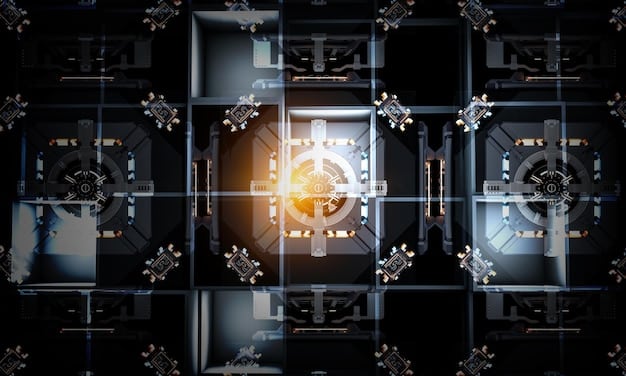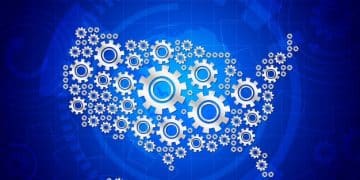AI & Intellectual Property: Protecting Innovations in the US in 2025

Protecting intellectual property in the age of AI in the US market by 2025 requires a proactive approach, focusing on patents, copyrights, trade secrets, and evolving legal frameworks to safeguard AI-driven innovations.
Navigating the intersection of AI and Intellectual Property: Protecting Your Innovations in the US Market in 2025 requires more than just innovation; it demands a strategic approach to safeguarding those innovations in a rapidly evolving digital landscape.
Understanding the AI and IP Landscape in the US
The convergence of artificial intelligence and intellectual property law is creating both opportunities and challenges for innovators in the United States. As AI systems become more sophisticated, the question of how to protect AI-generated inventions and creations has become increasingly important.
Understanding this landscape requires a grasp of the existing intellectual property laws and how they apply to AI, as well as staying informed about emerging legal trends and debates.
Current IP Laws and AI
Existing intellectual property laws, including patent, copyright, and trade secret law, can be used to protect different aspects of AI technology. However, these laws were not originally designed to address the unique characteristics of AI, so their application to AI is not always straightforward.
- Patents: Patents can protect novel and non-obvious AI algorithms and systems. However, obtaining a patent for AI can be challenging, as AI inventions often involve complex mathematical formulas and abstract ideas.
- Copyrights: Copyright protects the expression of an idea, such as the code and data used to train an AI system. However, copyright law may not protect the underlying functionality of the AI system.
- Trade Secrets: Trade secrets can protect confidential information that gives a business a competitive edge, such as the architecture of an AI system or the data used to train it. However, trade secrets are only protected if the information is kept confidential.

It’s crucial to consult with an intellectual property attorney to determine the best way to protect your AI-related innovations.
Strategies for Protecting AI-Driven Inventions
Protecting AI-driven inventions requires a multi-faceted approach that considers all available forms of intellectual property protection. This includes developing a comprehensive IP strategy that takes into account the specific nature of the AI invention and the business goals of the innovator.
Here are some key strategies for protecting AI-driven inventions:
Patent Protection
Filing for patent protection is a critical step in protecting AI-driven inventions. To obtain a patent, the invention must be novel, non-obvious, and useful. The patent application should clearly describe the invention and how it works, including the underlying algorithms and data structures.
Copyright Protection
Copyright can be used to protect the code and data used to train an AI system. Copyright protection is automatic upon creation, but it is advisable to register the copyright with the US Copyright Office to enhance enforceability.
- Protecting training data is crucial, especially if it contains original expressions.
- Carefully document the creation and modification of AI code to establish ownership.
- Regularly update and register new versions of your AI software.
A well-documented and consistently updated paper trail is essential for defending copyright claims.
The Role of Trade Secrets in AI Innovation
Trade secrets play a vital role in protecting AI innovations, particularly when patent protection is unavailable or undesirable. Trade secrets can protect confidential information, such as algorithms, training data, and customer data, that gives a business a competitive edge.
To maintain trade secret protection, businesses must take reasonable steps to keep the information confidential.
Implementing Strong Security Measures
Protecting trade secrets requires implementing strong security measures to prevent unauthorized access to confidential information. This includes physical security measures, such as access controls and surveillance systems, as well as cybersecurity measures, such as firewalls, intrusion detection systems, and data encryption.
Employee Training and Agreements
Employees are often the weakest link in trade secret protection. Businesses should provide regular training to employees on the importance of protecting confidential information and the procedures for doing so.
- Implement confidentiality agreements with employees and contractors.
- Restrict access to sensitive information to only those who need it.
- Monitor employee activity to detect potential breaches of confidentiality.

By taking these steps, businesses can significantly reduce the risk of trade secret misappropriation.
Addressing AI Authorship and Inventorship
One of the most challenging legal issues raised by AI is the question of authorship and inventorship. Current US law generally requires that an inventor or author be a human being. However, as AI systems become more capable of creating original works, the question of whether AI can be considered an inventor or author has become a subject of intense debate.
The US Copyright Office has taken the position that copyright protection is only available for works created by human beings. Similarly, the US Patent and Trademark Office (USPTO) has generally held that inventors must be human beings.
Arguments for and Against AI Authorship
There are arguments both for and against recognizing AI as an author or inventor. Proponents of AI authorship argue that AI systems can generate original works that are indistinguishable from those created by humans. They argue that denying AI authorship would stifle innovation and discourage investment in AI research.
Legal Precedents and Future Directions
To date, there are no legal precedents in the US that recognize AI as an author or inventor. However, the legal landscape is constantly evolving, and it is possible that this could change in the future.
As AI technology continues to advance, it is likely that the legal system will need to adapt to address the unique challenges raised by AI authorship and inventorship.
Preparing for Future Legal Challenges in 2025
The legal landscape surrounding AI and intellectual property is constantly evolving. Businesses that rely on AI technology must stay informed about emerging legal trends and be prepared to adapt their IP strategies accordingly. By 2025, we can anticipate further clarification—or perhaps increased complexity—in how AI-generated content is treated under the law.
Anticipating future legal challenges requires monitoring legislative developments, court decisions, and regulatory actions related to AI and intellectual property.
The Evolving Legal Landscape
The legal landscape surrounding AI and intellectual property is rapidly evolving. New laws and regulations are being proposed and enacted at both the state and federal levels to address the unique challenges raised by AI.
- Stay up-to-date on legislative developments and court decisions.
- Engage with industry groups and legal experts.
- Be prepared to adapt your IP strategy as the law evolves.
Proactive monitoring and adaptation are essential for maintaining effective IP protection.
Best Practices for AI-Related Intellectual Property in 2025
As we approach 2025, implementing proactive measures to protect AI-related intellectual property is more critical than ever. These best practices include conducting regular IP audits, maintaining detailed records of AI development processes, and implementing robust security measures to protect trade secrets.
Adopting a holistic approach to AI-related intellectual property can help businesses protect their innovations and maintain a competitive edge in the marketplace.
Conducting Regular IP Audits
Regular IP audits can help businesses identify and protect their AI-related intellectual property assets. These audits should assess the effectiveness of existing IP protections and identify areas where improvements can be made.
Consider these steps when conducting an audit:
- Identify all AI-related intellectual property assets.
- Assess the effectiveness of existing IP protections.
- Identify areas where improvements can be made.
| Key Aspect | Brief Description |
|---|---|
| 🔒 IP Protection | Strategies for patents, copyrights, and trade secrets on AI. |
| 🤖 AI Authorship | Challenges defining AI’s role in creating content and inventions. |
| 🛡️ Security Measures | Protecting AI models and data from breaches and unauthorized access. |
| ⚖️ Legal Compliance | Staying updated with changing AI regulations in the US. |
Frequently Asked Questions
▼
Currently, US law requires inventors to be human beings. AI cannot be listed as an inventor, though its contributions are considered in the invention’s patentability.
▼
Protect AI models through trade secrets, patents (if novel), and copyright the code. Implement security measures to restrict unauthorized access and reverse engineering.
▼
Secure AI training data using encryption, access controls, and data anonymization. Implement strict data governance policies and regularly audit for compliance.
▼
The US Copyright Office generally does not grant copyright protection to works solely generated by AI, requiring human authorship for work to be copyrightable.
▼
Update your AI IP protection strategy at least annually, or more frequently if there are significant changes in AI technology, business operations, or legal landscape.
Conclusion
As we look to 2025, navigating the complex intersection of AI and intellectual property requires a proactive, informed and adaptive strategy. By understanding the current legal framework, preparing for future developments, and implementing best practices, businesses can effectively protect their innovations and maintain a competitive edge in the rapidly evolving world of artificial intelligence.





